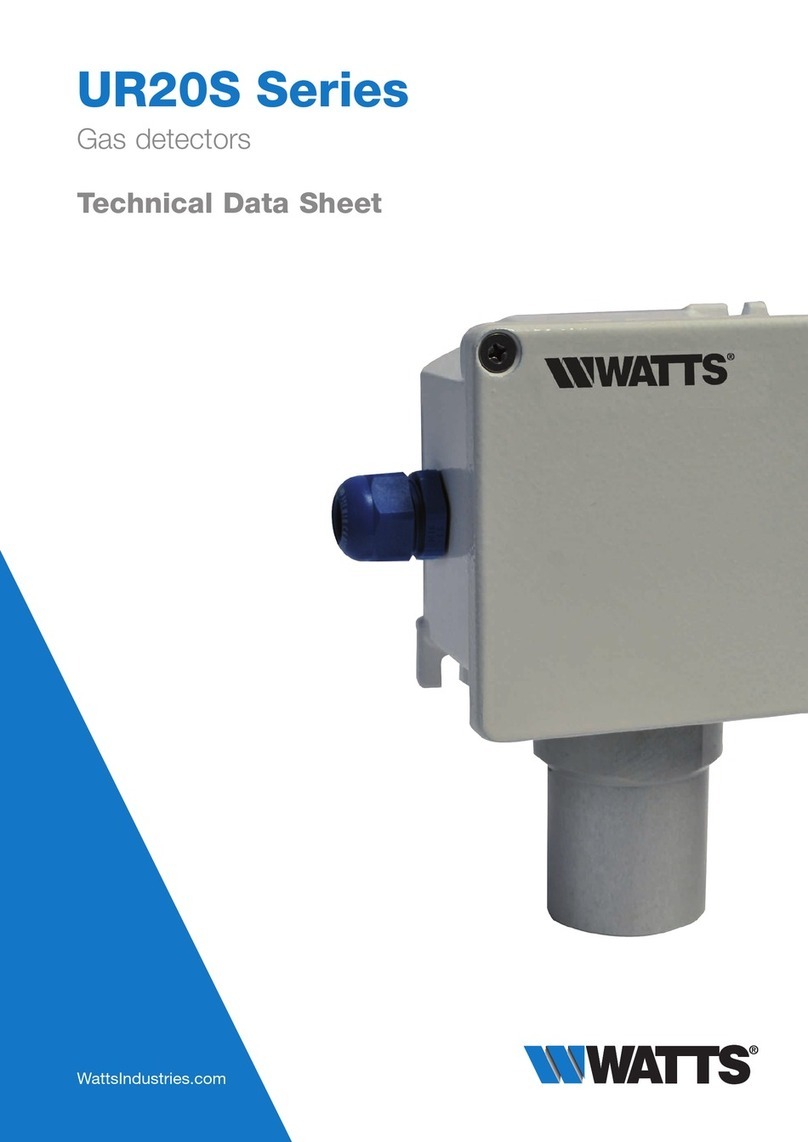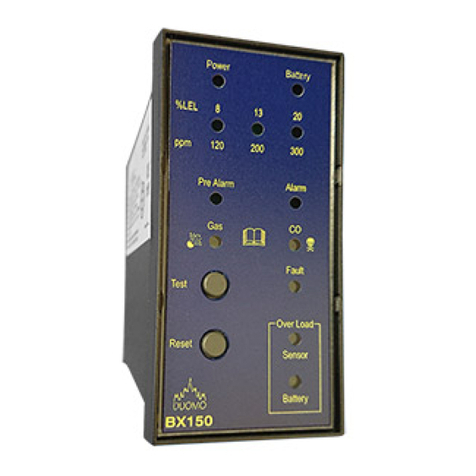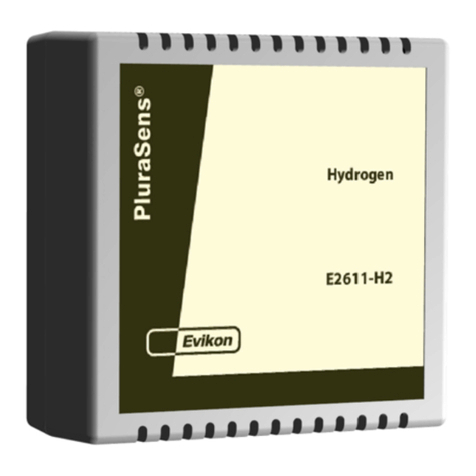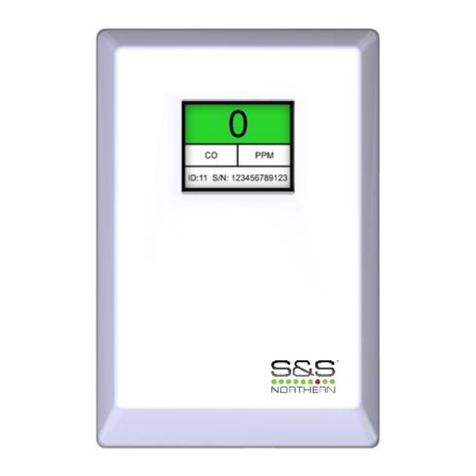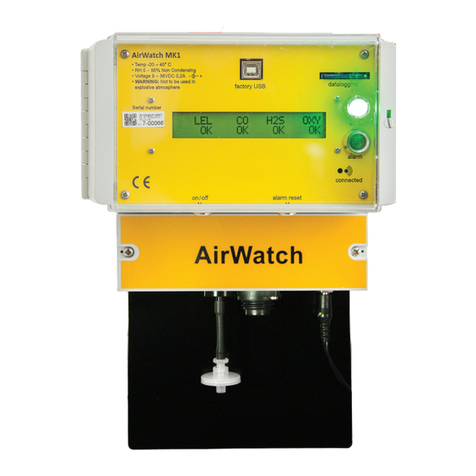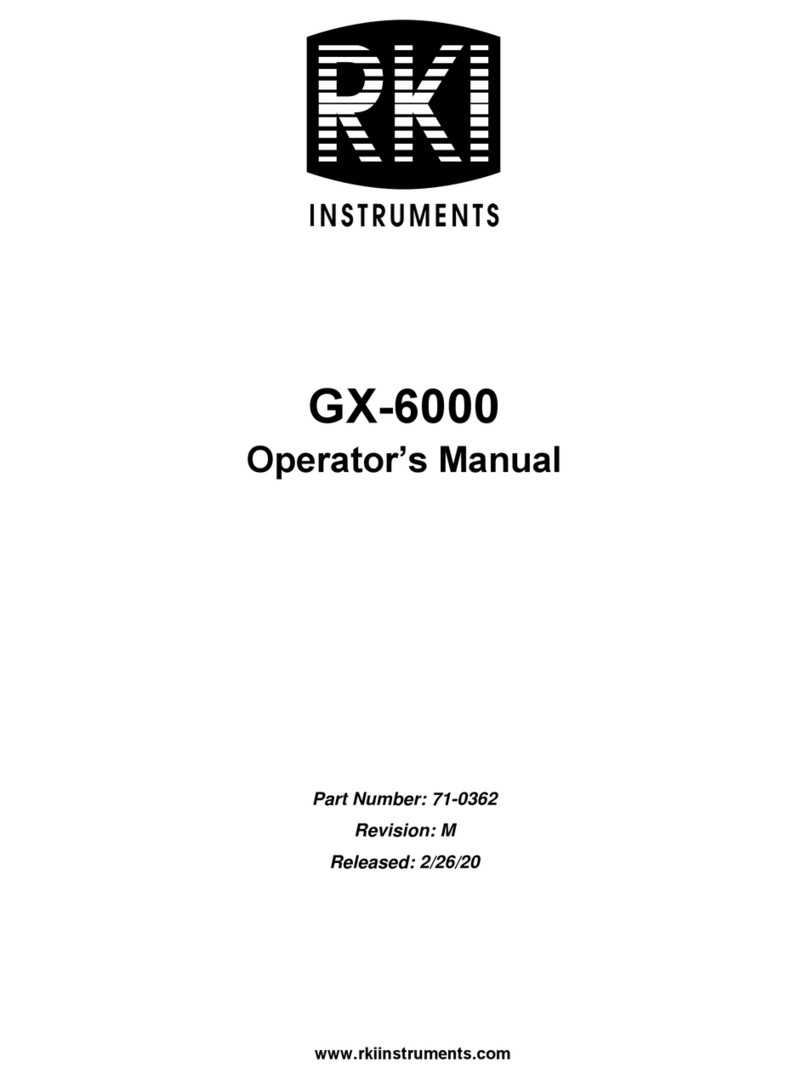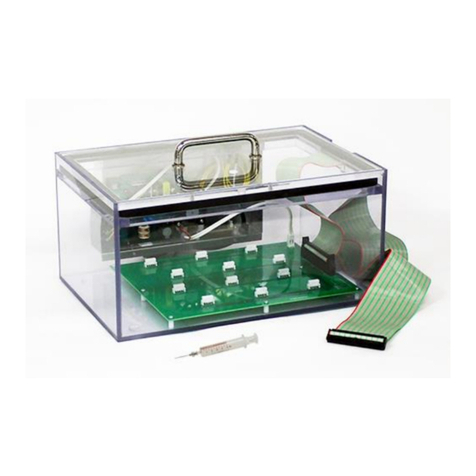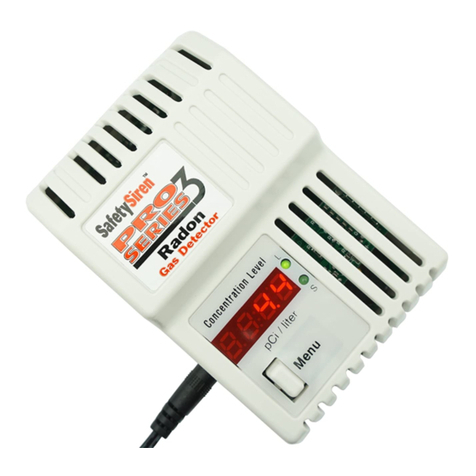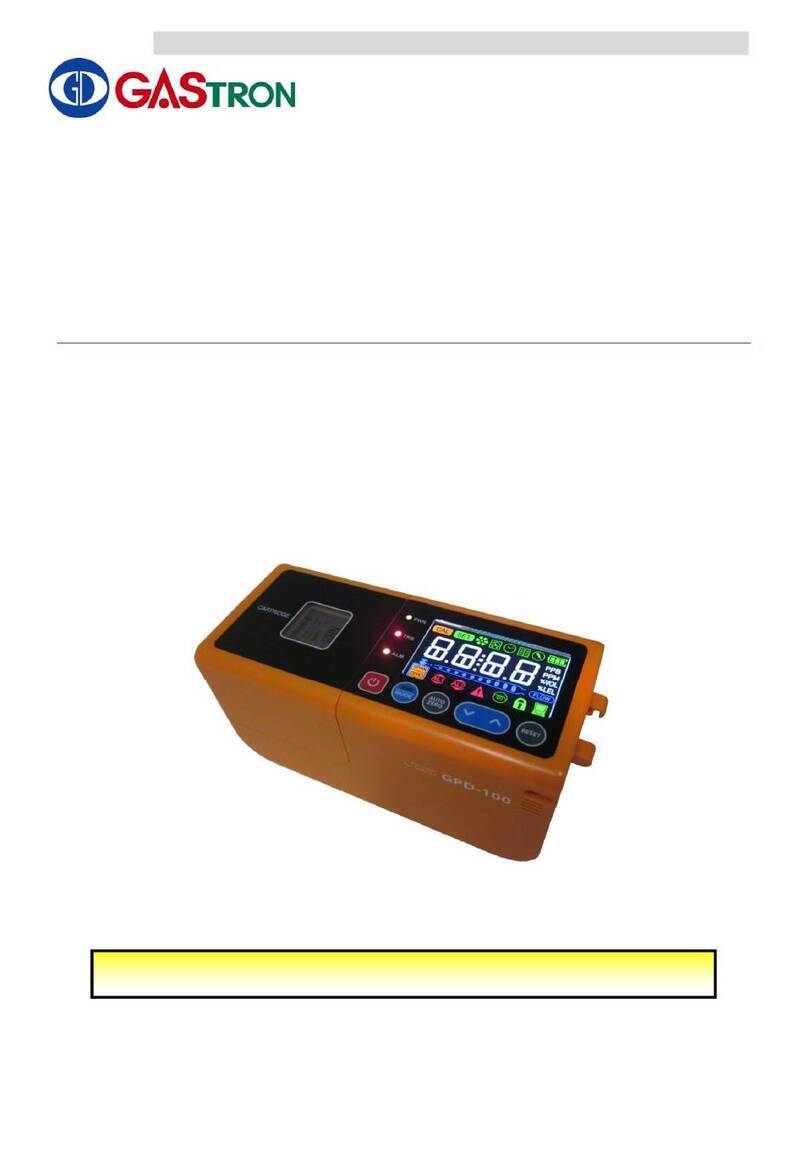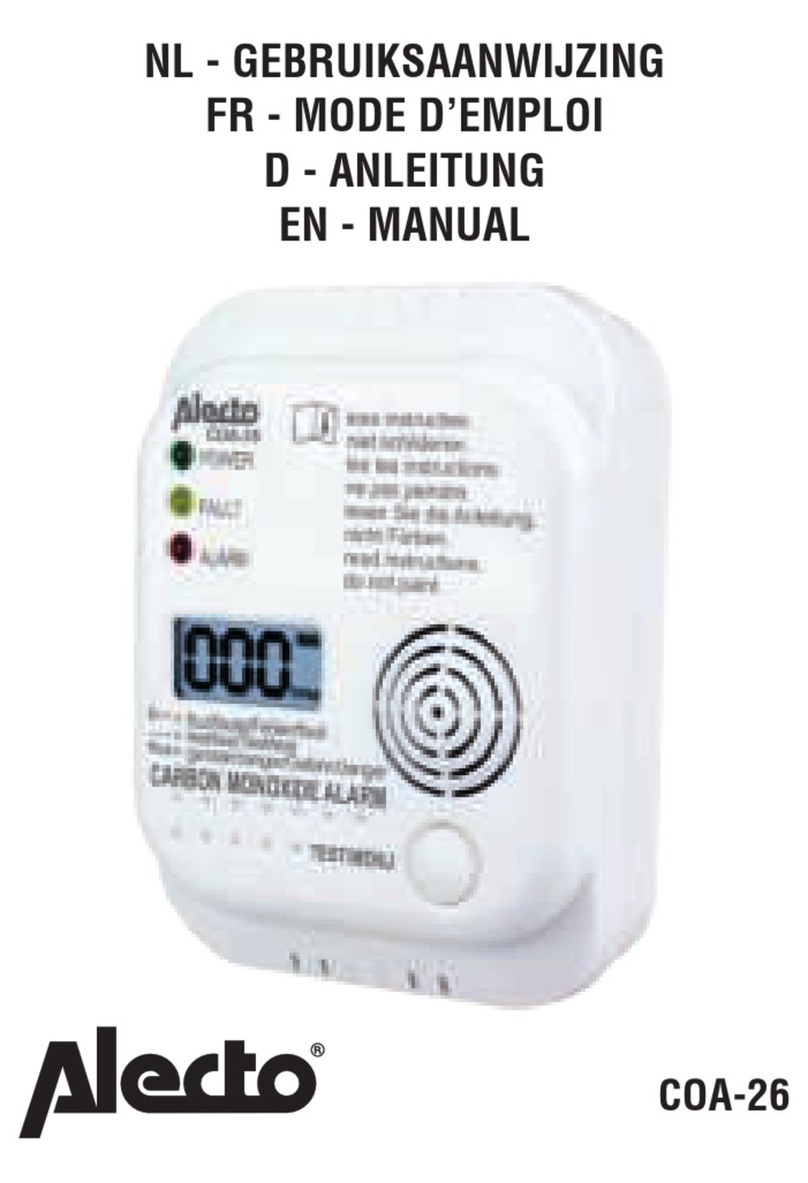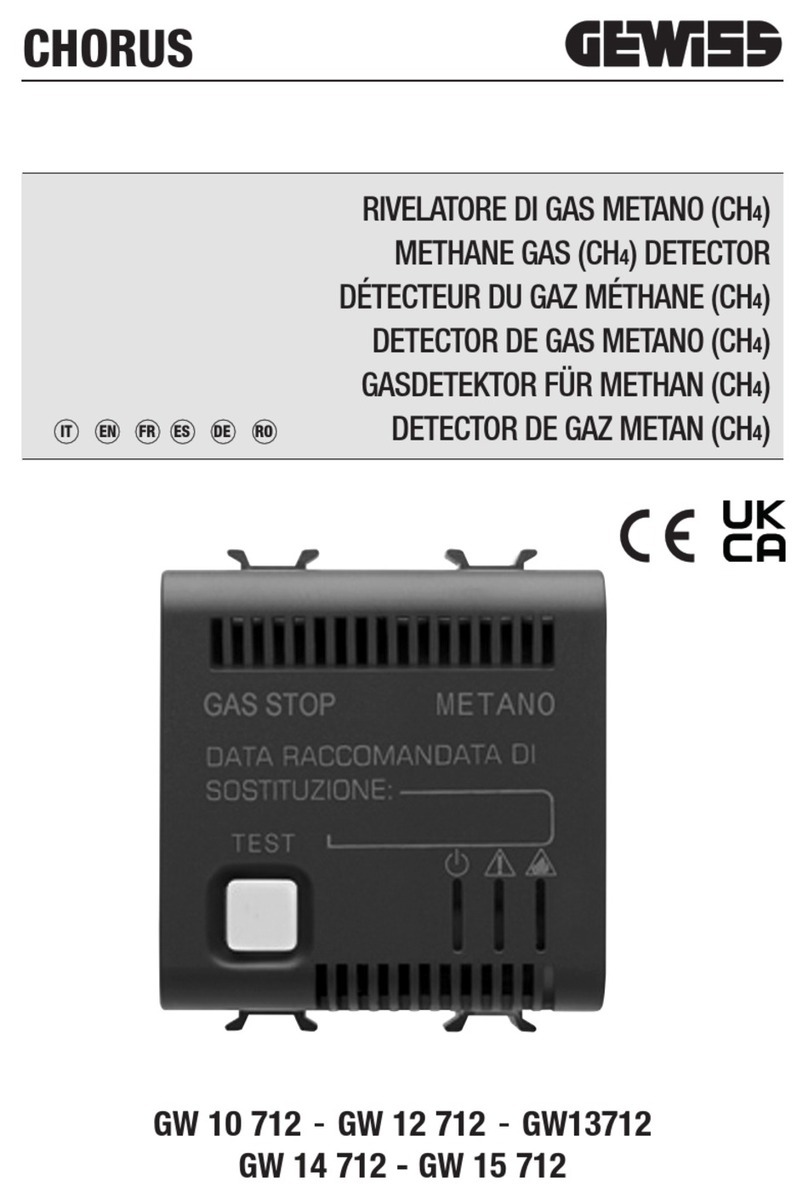Watts GSX Series User manual

LPG and Natural gas leak detectors
Series GSX - GSW
Main features
- Suitable for domestic applications
- Electronic operation based on microprocessor
- Available in the following versions :
• wall mounting
• flush mounting
- Provided with 2 setting/alarm thresholds
selectable by the user :
• 10% of LEL (default)
• 15% of LEL
- Automatic reset of the normal functioning
conditions when the concentration of the gas
goes below the threshold alarm.
- Provision for connection to GSM module for
sending SMS alarm messages.
- Conforms with European standards, namely :
• EEC 89/336 EMC, EEC 73/23 LVD,
EN50194 Certification pending

2
GAS LEAK DETECTORS
The new range of gas leak detectors under the name of “Gas Sentinel” for methane and LPG, available for wall
and flush mounting, comes with a new design and more compact size as well as with performance characteristics,
in terms of reliability and sensitivity in measurement, in accordance with current European standards (EN50194).
The alarm and closing of the solenoid valve are activated by the first or second threshold
depending on the programming of gas leak detector, selectable by user.
• Provision for simultaneous monitoring, through serial communication link, up to 11 zones:
(1 main detector + 10 secondary detectors)
• Provision for connecting the network of gas leak detectors to a PC for monitoring or programming the detectors
using a special software kit.
• Malfunction: the gas leak detector is provided with circuit for self-diagnostics, which, in the event of
critical fault of the sensor or to one of the main components, trips giving a visual signal (yellow LED).
Conforms with EEC 89/336, EEC 73/23, EN 50194.Certification pending.
Description
GAS SENTINEL
Gas leak detector, for domestic applications, for wall mounting, controlled
electronically via microprocessor, with audible and visual alarm, to be connected
to one or more solenoid valves, either normally closed (EVNC, EVNCR,
EVNCROT) or normally open (EVNA, EVNAOT).
GSX
GAS SENTINEL
Characteristics like GSX but for flush mounting. Compatible with the more
frequent commercially available plates and electrical boxes to DIN standards.
GSW
Type Part. No. Description Version Colour Weight (g)
GSW 0941020 Methane and natural gas Flush White 230
GSW 0941520 LPG, propane, butane Flush White 230
GSW 0941021 Methane and natural gas Flush Grey 230
GSW 0941521 LPG, propane, butane Flush Grey 230
Type Part. No. Description Version Colour Weight (g)
GSX 0941010 Methane and natural gas Wall White 230
GSX 0941510 LPG, propane, butane Wall White 230
Technical characteristics
Power supply 230V - 50Hz
Power consumption max 3 W
Relay contact load capacity (resistive) 5A - 250V
Gases monitored (MET version) methane, natural gas
(LPG version ) propane, butane, LPG
Alarm thresholds 1st threshold = 10% LEL (default) - 2nd threshold = 15% LEL
(L.E.L. = Lower Explosion Limit)
Operating temperature -15 °C ÷ 50 °C
Storage temperature 0 °C ÷ 50 °C
Humidity for using and storage 30 ÷ 95%
Insulating Class II
Degree of protection IP 42
Overall dimensions GSX - wall mounting 125 x 82 x 47 mm
GSW - flush mounting 115 x 66 x 62 mm

GAS LEAK DETECTORS
3
Gas leak detector kit, for domestic applications, for wall and flush installation,
coupled with normally open (EVNAOT) or normally closed (EVNCROT) solenoid
valves, with manual reset.
• NO or NC solenoid valves
- Brass body
- Power supply:230V
- Max. operating pressure: 500mbar
- Operating temperature: -15°C /60°C
- FF threaded connections: DN15 or 20.
- Degree of protection: IP65.
Conforms with EEC 89/336, EEC 73/23.
KIT GAS SENTINEL
Type Part. No. Description Version Colour
GSX/15NA 0941550 LPG, propane, butane Wall White
GSX/20NA 0941551 LPG, propane, butane Wall White
GSX/15NA 0941050 Methane and natural gas Wall White
GSX/20NA 0941051 Methane and natural gas Wall White
GSX/15NC 0941560 LPG, propane, butane Wall White
GSX/20NC 0941561 LPG, propane, butane Wall White
GSX/15NC 0941060 Methane and natural gas Wall White
GSX/20NC 0941061 Methane and natural gas Wall White
GSW/15NA 0941575 LPG, propane, butane Flush Grey
GSW/20NA 0941576 LPG, propane, butane Flush Grey
GSW/15NA 0941075 Methane and natural gas Flush Grey
GSW/20NA 0941076 Methane and natural gas Flush Grey
GSW/15NC 0941585 LPG, propane, butane Flush Grey
GSW/20NC 0941586 LPG, propane, butane Flush Grey
GSW/15NC 0941085 Methane and natural gas Flush Grey
GSW/20NC 0941086 Methane and natural gas Flush Grey
The “Gas Sentinel” gas leak detectors can be used for domestic application for the purpose of measuring the
concentration of the gas, present in the monitored zones; it comes in the:
• MET version: methane gas or natural gas
• LPG version: butane or propane gas or liquefied petroleum gases
When the concentration of the gas to be monitored exceeds the preset threshold, the gas leak detector is
activated with an audible and visual alarm.
The flush version is compatible with the more common commercially available plates and electrical boxes to
DIN standards.
AVE System 45 - Banquise
BTicino Light
BTicino Living, Living International
Gewiss Playbus
Gewiss Top System
Vimar Idea
Vimar Plana
Application
Operation of the “Gas Sentinel” gas leak detector, in both wall and flush installation versions, is through an
electronic circuit based on a microprocessor of the latest generation. A transformer and sensor are mounted on
the PC board of each gas leak detector. When a threshold is exceeded, the sensor activates an audible/visual
alarm and shuts off the gas supply by activating the solenoid valve (normally closed or open), if connected, long
before the gas concentration reaches hazardous levels in the domestic environment were the gas leak detector
is installed.
The sensor used (“nose”) is a solid-state element, semi-conductor type (non catalytic).
Operation

4
GAS LEAK DETECTORS
Expected working life of the sensor is 10 years; in this connection, the PC board of the leak detectors is provided
with a built-in memory which activates a flashing yellow LED upon reaching 10 years of operation, to indicate that
it is advisable to replace the detector (the internal sensitive element is liable to natural aging; its sensitivity is
increased accordingly, hence always to the advantage of safety).
Moreover the memory allows checking, if returning the unit to the factory, the serial N°, running hours, the number
of times the leak detector has entered alarm condition, etc.
The “Gas Sentinel” gas leak detectors are provided
with a programming and silencing button plus a series
of LEDs signalling the operating status of the detector :
Programming button:
Service button, located under the adhesive label, can
be activated by hand. It allows:
1) Access to the programming menu and setting the
gas leak detector operating parameters.
2) Silencing the buzzer for 1 minute in case of alarm.
LEDs :
Under normal operating conditions, the LEDs are in the following configuration :
1) Green LED: power,
- if lit up, it indicates that the gas leak detector is switched on.
- if unlit, it indicates that the gas leak detector is off,
- if flashing, it indicates that the programming procedure is activated.
2) Yellow LED: malfunction. Unlit under normal operating conditions.
3) Red LED: alarm 10% LEL. Unlit under normal operating conditions.
Red LED: alarm 15% LEL. Unlit under normal operating conditions.
Self-diagnostics
The electronic circuit of the gas leak detectors is provided with a self-diagnostics program which continuously
monitors operation of the gas leak detector: any malfunction, critical fault on the sensor or main components, is
indicated via a visual signal (yellow LED). In this case, the gas leak detector should be sent to the factory for
checking.
Setting
The gas leak detector is factory-set with 2 different alarm thresholds, namely: 10% and 15% of the LEL and leaves
the factory set to 10% of the LEL. If the user has too many false alarms (e.g. generated by products such as
bleach, wine, etc.), he can select the 15% alarm mode (however always at a value lower than the max. one
prescribed by regulations - 20%).
When the gas leak detector is set for mode of operation based on 10% LEL and the gas concentration exceeds
this threshold, a prealarm is displayed (first red LED flashing); if the concentration of gas remains for more than
30 seconds, the leak detector enters the alarm status:
• steady red LED,
• buzzer activated,
• relay switched.
Likewise in the case of the gas leak detector set to 15% LEL, if the gas concentration exceeds this threshold, a
first prealarm is displayed (2nd red LED flashing); the leak detector then passes to the alarm status only when the
concentration of 15% LEL is exceeded for more than 30 seconds (2nd red LED steady).
Red 2° setting alarm threshold (15% LEL)
Normally switched off, if switched on alarm
condition
Red 1° setting alarm threshold (10% LEL)
Normally switched off, if switched on alarm
condition
Yellow Fault
If switched on, malfunction or broken
signal
Green Power
Always switched on normally functioning
Service button
Allowed to programming and silencing alarm (1 min).
Warm-up of the sensor element :
Gas Sentinel has a warm-up time of 2.5 minutes starting from the powering of the gas leak detector, during which
the LEDs light up in rotation and the leak detector is not activated. This is the time required for bringing the sensor
to its operating temperature which is 140°C.

GAS LEAK DETECTORS
5
Normal operation
Malfunction
Alarm
After the warm-up time, the gas leak detector enters normal operating condition. Under this condition, the leak
detector performs self-diagnostics of the electronic circuit. A green LED light indicates “power on” and normal
operating condition of the unit.
If a malfunction occurs (e.g. breakage of the sensor element) the leak detector indicates the fault by showing a
yellow LED light. A flashing yellow LED indicates reaching the expected working life of the instrument (10 years).
After such indication, the leak detector operates normally but its replacement is recommended (the internal sensor
element is subject to natural aging).
The “Gas Sentinel” gas leak detector is provided with an alarm delay timer to avoid faulty indications due to
momentary increases in concentration of the gas. When the alarm threshold is exceeded, the intermittent optical
(red LED) and audible (internal buzzer) alarms are given. If the gas concentration exceeds the first alarm threshold
10% LEL, just the first red LED lights up, while if the concentration exceeds the second threshold 15% LEL, both
red LEDs light up. If the alarm persists for a time exceeding 30 seconds, the gas leak detector enters the alarm
status: the alarm light becomes steady and the buzzer is activated, while the relay causes closing of the solenoid
valve. The alarm and closing of the solenoid valve are activated at the first or second gas concentration depending
on the gas leak detector. When the concentration of the gas goes below the threshold alarm the gas leak detector
stops the alarm automatically and resets the normal functioning conditions. By pushing the “Prog” button it’s
possible to stop the alarm for 1 minute.
To check for correct performance of the “Gas Sentinel” gas leak detectors, using a gas bottle test, discharge a
small quantity of gas at the opening and wait. If necessary, repeat the operation. The instrument will indicate the
presence of gas with a beep and lighting up of one or two intermittent red LEDs. If the gas is detected for more
than 30 seconds (internal delay provided in order to avoid spontaneous signalling), the alarm configuration (red
LED lit up and buzzer on) is activated. After the set delay time, the pilot relay of the solenoid valve will also be
energized. Test functioning by a common lighter is not recommeded, as it makes the gas concentration peak too
high, resulting in the sensor giving an incorrect reading for a week.
Performance tests
The “Gas Sentinel” gas leak detectors have provision for simultaneous monitoring, through a serial
communication link, of up to 11 zones. This is done by a programming procedure whereby one detector is set as
the main one (Master) and the other 10 detectors as secondary (Slave units).
When the solenoid valve is present, it must be connected to the Master leak detector.
When installing two or more leak detectors in network, the alarm condition produced in a slave detector will also
cause the alarm in the master and closing of the solenoid valve to which it is connected. The flashing green LED
on the master indicates that the alarm has been transmitted by a slave unit.
On the other hand, the alarm produced in a master will not cause activation of the slaves.
Networking
The “Gas Sentinel” gas leak detectors, with sensors of semi-conductor type, are calibrated individually in cells with
the specific gas after an extended stabilizing warm-up of the sensor.
This guarantees maximum security of the gas leak detector for the user because :
- the sensors are calibrated under conditions identical to actual operating conditions;
- the warm-up ensures maximum stability in the level of calibration of the sensor.
The semi-conductor type of sensors used in the gas leak detectors combine the advantage of increased
sensitivity over a period of time with good selectivity characteristics and long working life.
RELIABILITY OF THE SENTINEL GAS LEAK DETECTORS

6
GAS LEAK DETECTORS
Install the “Gas Sentinel” gas leak detector in a position where the gas to be monitored tends to build up, with
reference to figures 1 and 2 :
Installation
•For LPG version (butane, propane, LPG) at a max distance of 30 cm from the floor
max 4 m
GAS
30 cm
30 cm
min. 30 cm
max.
max.
NET
MASTER
NET
SLAVE
SLAVE
max 4 m
min. 30 cm
max 4 m
min. 30 cm
Installation example for methane gas leak detector
max 4 m
GAS
min. 30 cm
NET
NET
MASTER SLAVE
SLAVE
max 4 m
min. 30 cm
max 4 m
min. 30 cm
max. 30 cm
max. 30 cm
Installation example for LPG gas leak detector
•For MET version (for methane or natural gas) at a max distance of 30 cm from the highest point
of the ceiling
•install the gas leak detector (for wall or flush mounting) at a distance lying between 0.30 and 4 m from
gas-fired appliances.
•do NOT install the gas leak detector in the vicinity of sinks, hobs, vents or extractor fans.
Examples showing incorrect installations
0
1
234
5
6
Incorrect installation
Correct installation
Fig.1
Fig.2

GAS LEAK DETECTORS
7
a) Installation of wall-mounting gas leak detector “GSX” :
Installation of wall-mounting version GSX
REMOVAL :
1) Prise the spring tab with a screw-driver
2) Pull the leak detector to the right
3) Lift the leak detector from the frame
1
3
INSTALLATION :
1) Secure the frame to the wall
2) Make the electrical connections
3) Insert the leak detector in the frame
2
2
13
b) Installation of flush-mounting gas leak detector “GSW” :
Installation of flush mounting version GSW
1) Depending on the type of plate to be
installed, either cut or not cut the side tabs,
and remove or not remove the side lugs.
2) Connect the power supply, solenoid valve
and, if necessary, the serial communication.
3) Insert the gas leak detector in the electric
wall box provided and fasten it with the two
screws supplied as standard kit.
4) Apply the plate chosen.
5) Affix the adhesive label with the leak
detector replacement date.
3
2
5
4
1
The “Gas Sentinel” gas leak detector does not require maintenance.
Periodically remove deposits of dust by using a dry rag; do not use alcohol or solvents. It is not possible to vary
the gas leak detector calibration; if the fault (yellow) indicator lamp lights up, replace the product and send the
non-functioning product to the technical service.
Maintenance
No spare parts are available.
Spare parts

8
GAS LEAK DETECTORS
Connect the “Gas Sentinel” gas leak detector to the 230V - 50Hz power supply using relative terminals (N - L);
connect the solenoid valve, if necessary, via relative terminals (Nc - C - No) according to the wiring diagram given
in figures 3 and 4.
Use electrical cables with minimum size smaller than 1,5 mm 2 ; use cables provided with suitable insulation.
Electrical connections
NL + -Nc C No
NET
230V~ 50Hz
EVNC
Normally Closed
Solenoid valve
NL + -Nc C No
NET
EVNA
Normally Open
Solenoid valve
230V~ 50Hz
1 - Connection to solenoid valve 230V-50Hz
EVNA
Normally Open
Solenoid valve
230V~ 50Hz
NL + -Nc C No
NET
NL + -Nc C No
NET
EVNC
Normally Closed
Solenoid valve
12VCC
12VAC
24VCC
24VAC
12VCC
12VAC
24VCC
24VAC
230V~ 50Hz
2 - Connection to solenoid valve 12VCC - 12VAC - 24VCC - 24VAC
Re-order no. 64-0001-UK-IT/1-06-01-Rev.0
Watts Industries Italia S.r.l.
Via Brenno, 21 - 20046 Biassono (MI), Italy
Ph. : +39 039 49.86.1 - Fax : +39 039 49.86.222
www.wattsindustries.com
The descriptions and photographs contained in this product specification sheet are supplied by way of information only and are not binding.
Watts Industries reserves the right to carry out any technical and design improvements to its products without prior notice.
Fig.3
Fig.4
This manual suits for next models
25
Table of contents
Other Watts Gas Detector manuals
Popular Gas Detector manuals by other brands
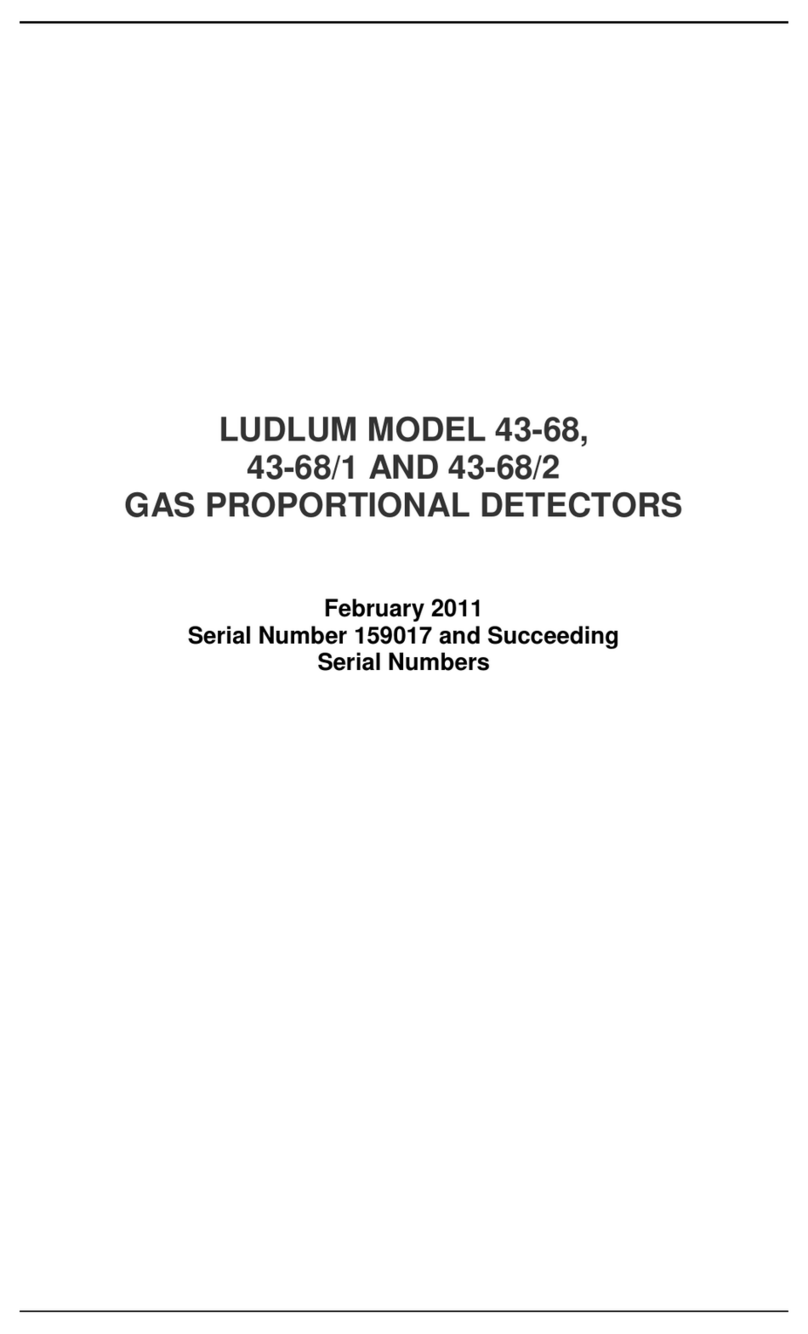
Ludlum Measurements
Ludlum Measurements 43-68 manual

Elektrotechnik Schabus
Elektrotechnik Schabus GX-B2pro operating instructions
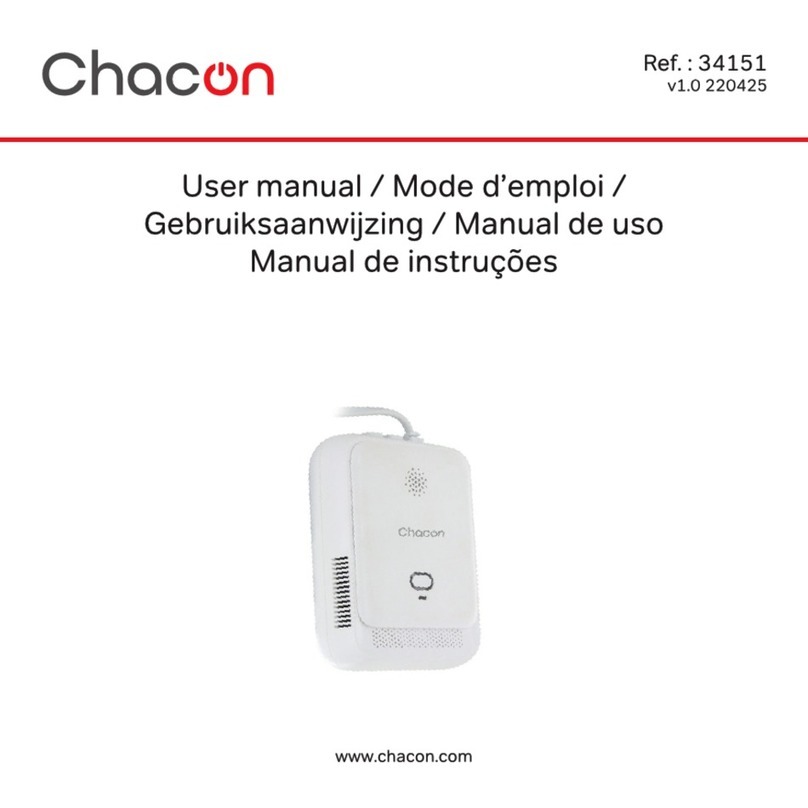
Chacon
Chacon 34151 user manual
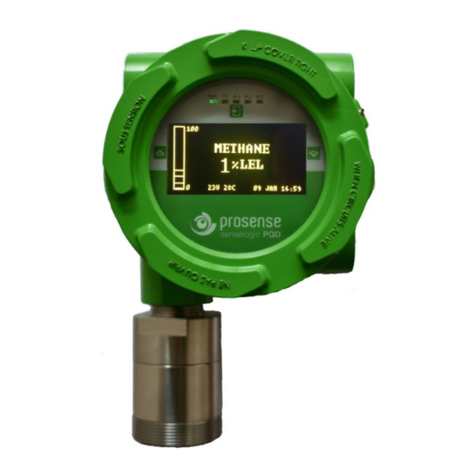
Prosense
Prosense PQ Series Quick installation guide
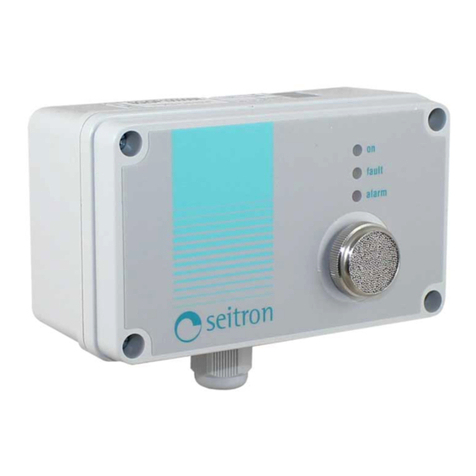
Seitron
Seitron SGI 1 M Series instruction manual
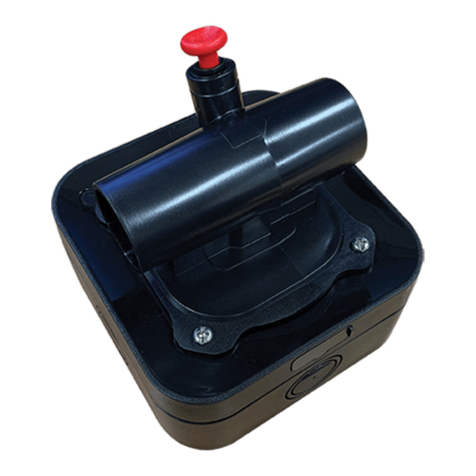
VESDA
VESDA Sensepoint XCL installation manual
